60 Zebra Facts for Animal Lovers and Africa Travelers (All 3 Species)
Zebras are intriguing animals. They look like horses with black and white stripes. In this post, you’ll learn 60 zebra facts. They include habits, habitat, risks, speed, coloring and more. Can you own a zebra as a pet? Why do zebras have stripes? Read on to learn the answers to these questions and other fascinating zebra facts.
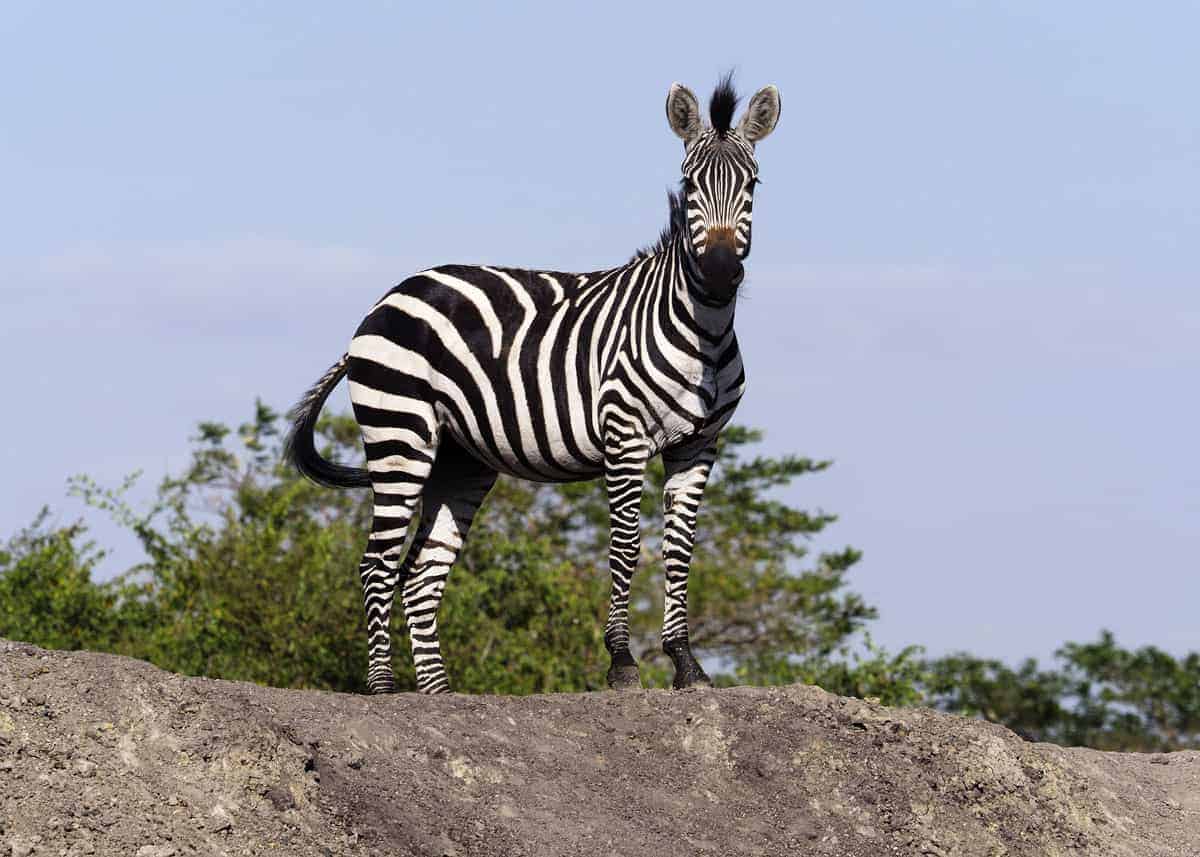
Travel Tip: we recommend a good pair of binoculars and a good safari-grade camera with zoom lens. These will allow you to see and shoot zebras from a safe distance – without disturbing them or their herd.
Zebra Overview: 3 Species
There are three species of zebra in Africa.
- Latin name(s): Equus grevyi; Equus zebra; Equus quagga
- Common names: Grévy’s zebra (Equus grevyi), Mountain zebra (Equus zebra), Plains or Common Zebra (Equus quagga)
- Number of species: 3
- Range: Southern and eastern Africa
- Population Status: E. grevyi (Endangered); E zebra (Vulnerable), E. quagga (Near Threatened)
- Height: 3.6 to 5 feet (1.1 to 1.5 m) at the shoulders
- Weight: 770 to 990 lbs (350 to 450 kg)
- Diet: Mostly grasses but occasionally herbs, shrubs, leaves, twigs and bark
- Physical features: Black and and white stripes
- Where it lives: Africa
60 Facts about Zebras
1. How many types of zebra species are there?
There are three main species of zebras:
- Mountain zebra (E. zebra): has a neck flap (dewlap) and sharp hooves for climbing in mountainous grasses.
- Plains zebra (E. quagga): is the smallest but most common zebra.
- Grevy’s zebra (Equus grevyi): is named after French President Jules Grévy. Shaped like a donkey, it’s the largest zebra species.
To help you visualize the differences, here are photos of all three zebra species:
Mountain Zebra
Plains Zebra (Common Zebra)
Grevy’s Zebra
2. Where do zebras live in Africa? What Areas?
Plains zebras live in eastern and southern Africa. Mountain zebras are found in South Africa, Angola, and Namibia.
Due to its population decline, Grevy’s zebras are confined to Somalia, northern Kenya and southern Ethiopia.
3. What is the zebras habitat?
Zebras love grassland habitats for grazing.
- For the plains zebras, this means grassy plains and wooded savannah.
- Mountain zebras are found climbing grassy hills.
- Grevy’s zebras prefer roaming arid grasslands and steppe.
Zebras don’t live in rainforests, wetlands or deserts, so climate change could pose a threat to them.
4. Where can I see zebras in Uganda?
Uganda is currently home to more than 3,000 zebras (primarily plains zebras).
Most of these can be seen in two national parks, Lake Mburo National Park and Kidepo Valley Park. You might also see zebras at Katonga Wildlife Reserve since some were translocated there in 2018.
Learn more about Uganda’s National Parks.
Random Zebra Questions
5. Is a zebra a horse?
Don’t mistake zebras for striped horses. They are in the horse family and are also closely related to donkeys, but they are distinct.
Zebras have never been domesticated like horses and are far more aggressive than horses.
6. Can you ride a zebra?
It’s possible to ride a zebra, but it’s not recommended.
Zebras are built smaller than horses and cannot support the weight of a human adult for a long period of time.
Plus, zebras are known to possess a ducking reflex that helps them avoid being lassoed like horses.
7. Are zebras mammals?
Yes, zebras are mammals. This means female zebras feature mammary glands that produce milk for nursing their babies.
8. Do zebras hibernate?
No, zebras do not hibernate like some animals do that live in extreme cold or hot climates to conserve energy or survive an extended period of time without food sources.
However, zebras do migrate to where food and water are more abundant. You can read more about these zebra facts in # 11 of this post.
9. Can you legally own a zebra?
In many countries, it’s perfectly legal to own a plains zebra but not a mountain or Grevy’s zebra since both of these species are endangered.
Anyone interested in owning a zebra should learn as much as they can about this animal because zebras aren’t domesticated and can be dangerous. Plus, they require plenty of room and need other zebras around them to be happy.
According to IZZZA (International Zebra-Zorse-Zonkey Association) there are around 3,000 zebras living in private homes across the United States.
10. Do zebras have good memory?
Yes, it appears that zebras do have a good memory.
According to a research study conducted by the Senckenberg Research Institute and Natural History Museum, zebras migrate every year by remembering good foraging conditions from their past.
11. How far do zebras migrate?
Every year around November, thousands of zebras, along with antelope and blue wildebeest, join together in an extraordinary migration event where they travel up to 1,800 miles in search of fresh food and water.
12. Do zebras sleep with one eye open?
No, it’s a myth that zebras sleep with one eye open. People probably say this meaning that they are always on guard against danger.
Like horses, they sleep standing up and only with other zebras around to help provide a warning against predators.
13. Do zebras have a good sense of smell?
Zebras do have a sharp sense of smell, but they also have excellent eyesight (including night vision), hearing and taste.
Their super senses help them to both detect danger and find food.
14. Can zebras run in a straight line?
Zebras are certainly capable of running in a straight line, but when being chased by a lion or any other predator, they run in a side-to-side zig-zag fashion like a suspect in a high-speed police chase to avoid being attacked.
15. Are there zebras in Australia?
Zebras are not native to Australia. Therefore, they do not live in the “land down under” in the wild.
However, you can probably see them in zoos there such as Australia Zoo (Queensland), Werribee Open Range Zoo (Victoria), Monarto Safari Park (South Australia), and Taronga Zoo (New South Wales).
16. Do zebras live in the jungle?
No, you won’t find zebras in the jungle since their preferred habitat is treeless grasslands, plains, and savannah woodlands.
17. Who discovered the zebra?
The zebra has been around for at least 4 million years, so it’s kind of hard to say who first discovered it.
Zebra Size and Color
18. How much does a zebra weigh?
This depends upon the species.
- The plains zebra is the smallest species and weighs on average around 770 pounds (350 kg).
- The largest, the Grevy’s zebra, weighs approximately 990 pounds (450 kg).
- The mountain zebra comes in the middle, weighing between 530 and 820 pounds (240 and 372 kg).
A baby zebra (or foal) weighs about 70 pounds (32 kg) at birth.
19. How tall is a zebra?
For comparison, zebras are usually shorter than horses and they range from 3.6 to 5 feet in height.
- Measuring from shoulder to hoof, Grevy’s zebras can grow up to 5 feet (1.5 m).
- Mountain zebras grow between 3.8 and 4.9 feet (1.16 and 1.49 m).
- The smaller plains zebra grows between 3.6 and 4.8 feet (1.1 and 1.46 m).
20. Are zebras black or white?
Are zebras black with white stripes or vice versa? That’s a question that’s often asked concerning zebra facts.
For a long time, many people believed that zebras were white with black stripes because some of them have white underbellies.
But recent research of zebra embryological development has proven that zebras are black underneath their white-striped fur coats.
21. What color are zebras born?
When a zebra foal is born, it has brown and white stripes instead of black and white. The foal’s stripes turn black between the age of 9 and 18 months of age.
22. Do golden zebras exist?
Although rare, golden zebras do exist. They’re also called “white zebras” because they feature an abnormal pigmentation that causes them to be white with golden or beige stripes instead of black.
Their condition is called amelanosis in which they lack melanin that produces dark pigmentation. One of these rare golden zebras, Zoe, melted hearts across the web.
23. What color is zebras skin?
The black and white stripes you see on a zebra make up this animal’s fur coat. The skin beneath the zebra’s fur coat is black.
24. Why do zebras have stripes? 4 reasons
No one knows for certain, but scientists agree that zebra stripes provide the following benefits:
- Differentiation: Like human fingerprints, zebra stripe patterns are unique to each individual, distinguishing one zebra from another.
- Protection: The confusing blur of stripes in a zebra stampede provides protection against predators.
- Insect repellent: Stripes deter biting insects.
- Cooling: The contrast of light-reflecting white stripes and light-absorbing black stripes creates a cooling mechanism.
25. Why are zebras black and white?
Zebras are black and white because their stripes provide them with camouflage, cooling and protection against predators and biting insects.
Did you know that each zebra species features a different pattern in their black and white stripes? For example, Grevy’s zebras bear much thinner stripes. Mountain zebras have a combination of horizontal and vertical stripes, and some plains zebras have brown shadowy stripes.
26. Are zebras black?
Yes, under their fur coats, zebras have black skin.
27. Are baby zebras born without stripes?
No. Baby zebras have stripes at birth. But their stripes are brown instead of black like their parents. Their stripes begin to turn black as they mature.
28. What colour are zebras at birth?
Zebras are born with brown and white stripes in contrast to their parents’ black and white stripes. Their stripes turn black when they are between 9 and 18 months old.
29. What sound does a zebra make?
Zebras can make a wide range of sounds.
Like horses, they can neigh, snort and whinny. Similar to donkeys, they can also bray, but it starts out more like a growl and ends in a high squeal. If a plains zebra spots a predator, it makes a barking sound like that of a dog.
Learn more about the sounds a zebra makes.
Zebra Population and Risks
30. Are zebras dangerous or friendly?
The beautiful sight of zebras may trigger an “aww” from you, but don’t underestimate them.
They are more temperamental and aggressive than horses with a kick that is powerful enough to break a lion’s jaw. They’re also fiercely protective of one another and will form a circle around one of their wounded in order to fight off an attacker.
31. Do zebras attack humans?
Zebras usually stay clear of humans, but they can attack humans if they feel threatened or cornered.
- November 2013: Wayne Millner, a veteran zookeeper, was attacked by a male Grévy’s zebra when he left a stall gate open.
- In 2010, a woman in Zimbabwe was attacked by a zebra she had raised from a foal.
Because zebras haven’t been domesticated like horses, they are very unpredictable.
32. What are zebras afraid of?
Zebras are afraid of being chased, attacked and eaten by predators which you can read about next.
33. What eats a zebra?
Predators like lions, leopards, cheetahs, hyenas, and African wild dogs like to eat zebras.
Crocodiles will surprise attack zebras and take them down at river crossings for their dinner. Some humans also hunt and eat zebras.
34. What are zebras good for?
Zebras, especially the plains species, promote quality grass to grow.
Unlike wildebeests and gazelles who are picky grazers, zebras are equipped with specialized digestive systems that can process older and poorer quality grass. Once a herd of zebras clears out older forage, it makes way for the better quality stuff to grow.
35. Are zebras endangered?
Yes. According to the IUCN Red List, Grevy’s zebras are the only zebras classified as Endangered.
Mountain zebras are listed as Vulnerable, and plains zebras are considered Near Threatened.
36. How many zebras are left?
Based on population estimates from the IUCN Red List, this is how many individuals are left for each of the zebra species:
- Grevy’s zebras: 1,956
- Mountain zebras: 34,979
- Plains zebras: 150,000 to 250,000
37. Why are some zebra species reducing?
The population numbers for all three species of zebras are decreasing due to habitat loss and livestock grazing.
They’re also hunted by humans for their skins and meat.
38. How large is the zebra population?
With all three zebra species combined, the overall population is estimated to be just under 300,000 individuals.
39. Why are Grevy’s zebras endangered?
Human interference is the largest threat to Grevy’s zebras which causes loss to their habitat since they’re forced to compete with cattle for water and grazing.
Poaching for their meat and skins is another serious problem that’s caused a decline in their numbers.
40. How long do Grevy’s zebras live?
Like other zebra species, Grevy’s zebras can live up to 20 or 25 years in the wild but up to 40 in captivity.
41. What is a group of zebra called?
A group of zebras is referred to as either a herd or dazzle, which is what happens to your mind when you see a herd of these striped creatures bolting through grassland in unison.
Zeal is another word that some have used to refer to a group of zebras.
42. How large is a herd of zebras?
Zebra herds can vary between family groups of 5 to 20 members to large congregations of 1,000 individuals.
Many herds consist of a dominant stallion with several mares and their foals. Other herds may be “bachelor herds” made up of males who are old enough to be separated from their mothers but too young to compete for females.
43. Why do zebras live in herds?
Zebras live in herds for protection.
Not only can they look out and warn each other against danger, but a herd will fight for one of its own if it’s attacked. Herds also protect foals by keeping them in the middle when traveling.
44. How fast can a zebra run?
Zebras need to run fast to avoid becoming dinner for predators like lions, so they can run up to 40 mph (65 kph). Here’s more about how fast zebras run.
45. Can you outrun a zebra?
No. Since the average human can only run about 28 mph (45 kph), you probably wouldn’t be able to outrun a zebra that can run up to 40 mph (65 kph).
But then again, humans usually don’t have to worry about outrunning predators like lions. And it would be rare to have to actually outrun a zebra.
46. How fast can a newborn zebra run?
Amazingly, zebra foals can keep up with the herd within just a few hours after birth. While this doesn’t mean that they run the same top speed as an adult (40 mph / 65 kph) it is still impressive.
If you have statistic to share about the speed of a zebra foal, please share it below.
47. Can you eat a zebra? Is it legal? What does it taste like?
It’s only legal to eat the meat of a Burchell zebra which is a subspecies of the plains zebra that is found in South Africa.
The most edible meat from this zebra is from the hindquarters, and it’s supposedly lean and tastes “sweeter than beef.”
Zebra Reproduction
48. How do zebras give birth?
Zebras give live birth to their young the same way as horses, donkeys and most other mammals.
49. How many babies can a zebra have?
Most of the time, zebras only deliver a single baby per birth. They have been known to have twins, but sadly, only one usually survives.
50. Do twin zebras have identical stripes?
No, if both twins survive they will not have the same stripes. Each foal will have unique stripe patterns.
51. How often do zebras give birth?
Zebras can give birth every twelve months, but they’re normally restricted to a mating season.
- Mating season for Grevy’s and plains zebras: Between August and October.
- Mating season for Mountain zebras: Peak season is between December and January. But they can breed throughout the year.
52. How long does the zebra foal stay with its mother?
Young zebras often stay with their mothers until they’re about three years old.
After this, the males will leave and join up with a bachelor herd while the females will remain in the same herd as their mother.
53. What is a female zebra called?
Like a female horse, a female zebra is called a mare.
54. How long does a zebra stay pregnant?
The gestation period for a female zebra is between 12 and 14 months.
Specifically, the plains zebra and mountain zebra are pregnant for about 12 months while the Grevy’s zebra stays pregnant closer to 14 months.
55. What age do zebras have babies?
Zebra mares mature earlier than stallions and may give birth to their first foals by the time they are three years old.
Stallions, on the other hand, aren’t ready to breed until they’re between four and six years of age.
56. Why do zebras kill foals?
It’s true that zebra stallions will sometimes kill a foal, especially one that’s been recently born after the stallion takes over the herd.
This behavior makes us humans sad, but it happens to be common among many animal species.
While scientists aren’t certain about the reason, they believe that zebra stallions may kill foals, especially males, to ensure that they’re not raising another stallion’s offspring that will grow up to be their competition.
57. How long can a zebra live?
Zebras can live up to 25 years in their natural habitat, depending upon factors like predators and food scarcity.
In captivity, they’ve been known to live up to 40 years.
58. Can a zebra and horse mate?
Yes, a zebra and a horse can mate, but it often involves human intervention.
The offspring of a zebra stallion and a horse mare is called a zorse. If the stallion is a horse, and the mare is a zebra, the offspring is called a hebra.
59. What is a zebroid?
A zebroid is an offspring of crossbreeding between a zebra stallion and any other member of the horse family. These zebroids result in a variety of striking colors and semi-striped patterns.
The most common zebroids include:
- Zebroid: Umbrella term for any zebra hybrid.
- Zorse (zebra + horse)
- Zony (zebra + pony)
- Zedonk (zebra + donkey)
60. Are zebra hybrids fertile?
No, zebra hybrids are not fertile.
Just like a mule (offspring of a horse and donkey) can’t reproduce, zebroids also cannot reproduce.
Your Turn
Now that you’ve read these zebra facts, were you surprised by any of them?
What impresses you most about zebras, and what else would you like to know about them? Let us know in the comments!

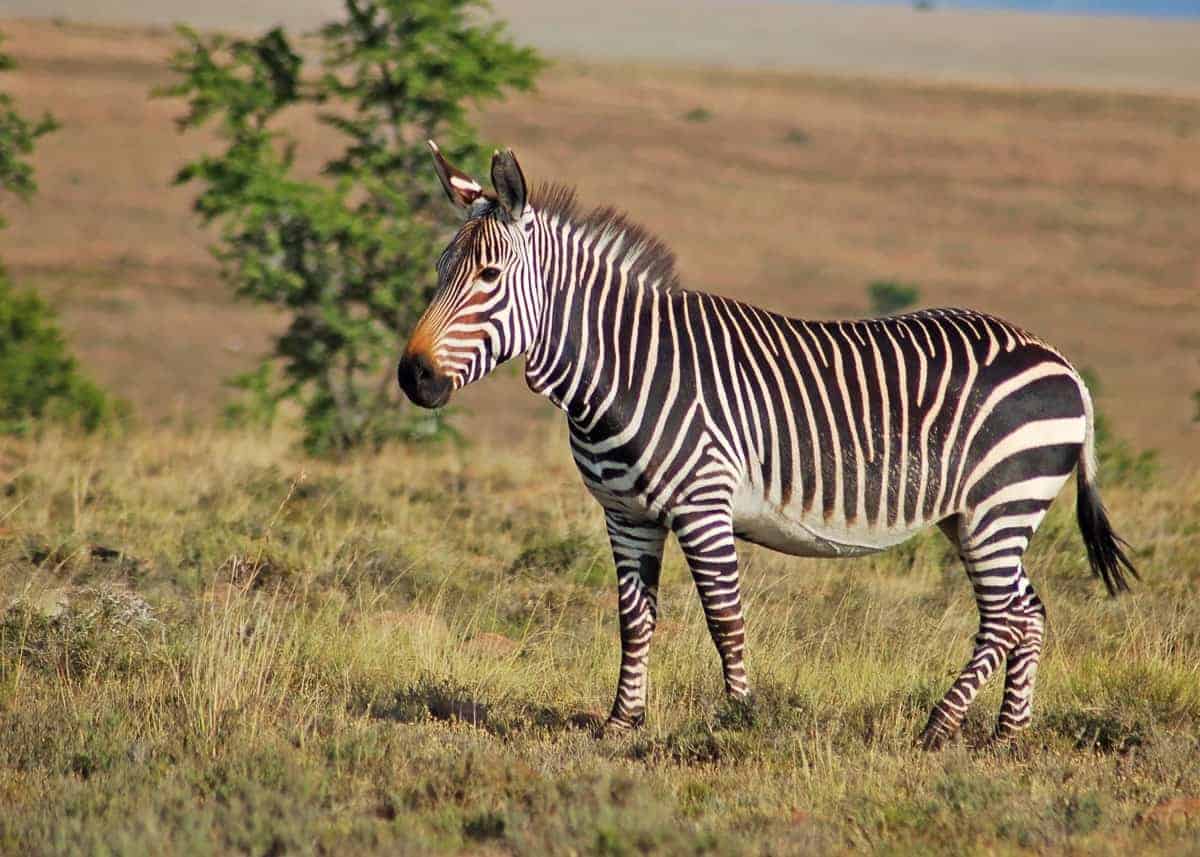
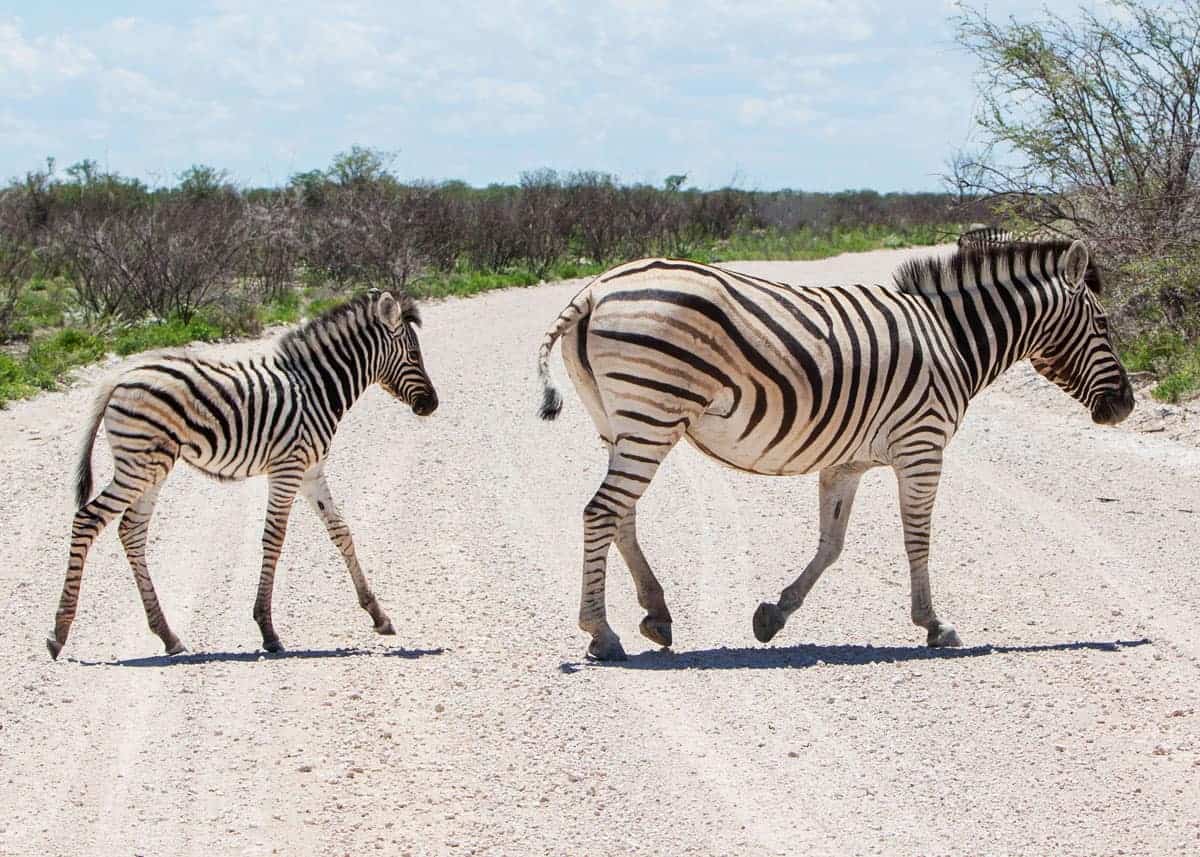
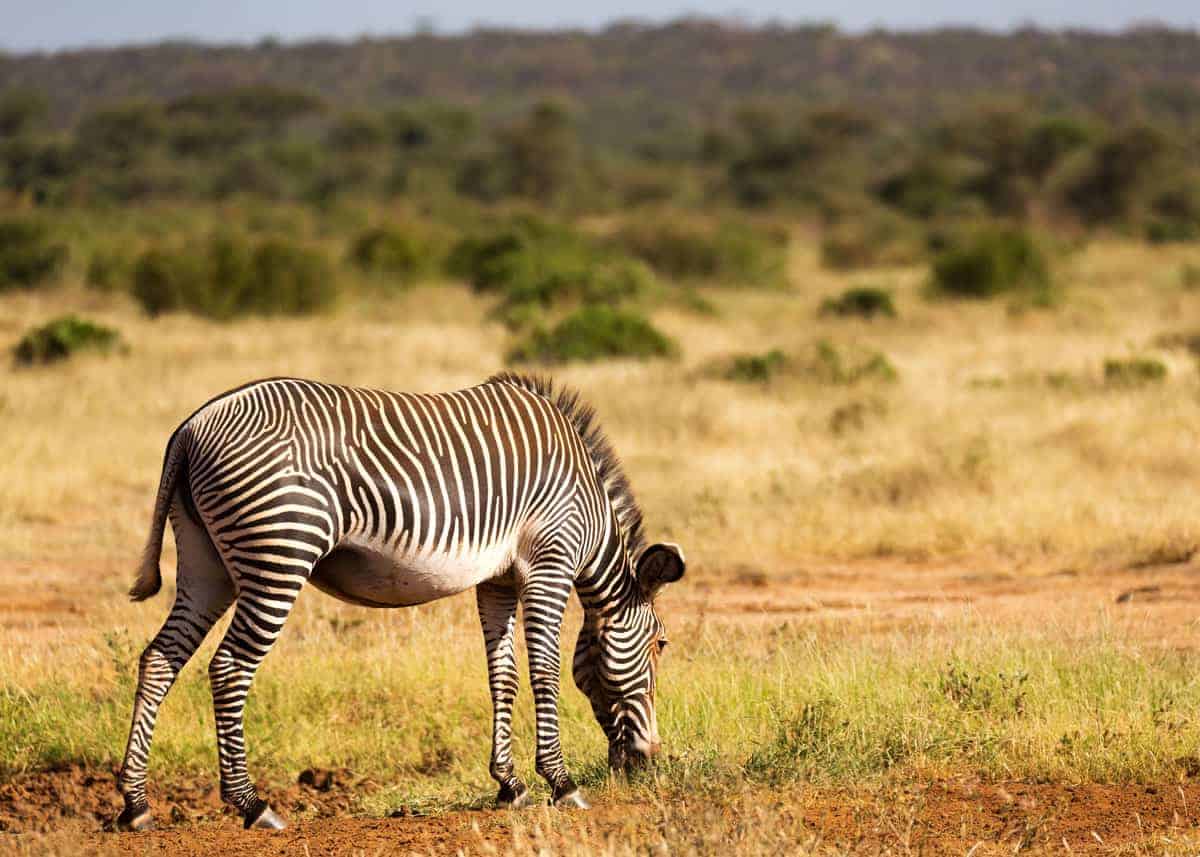
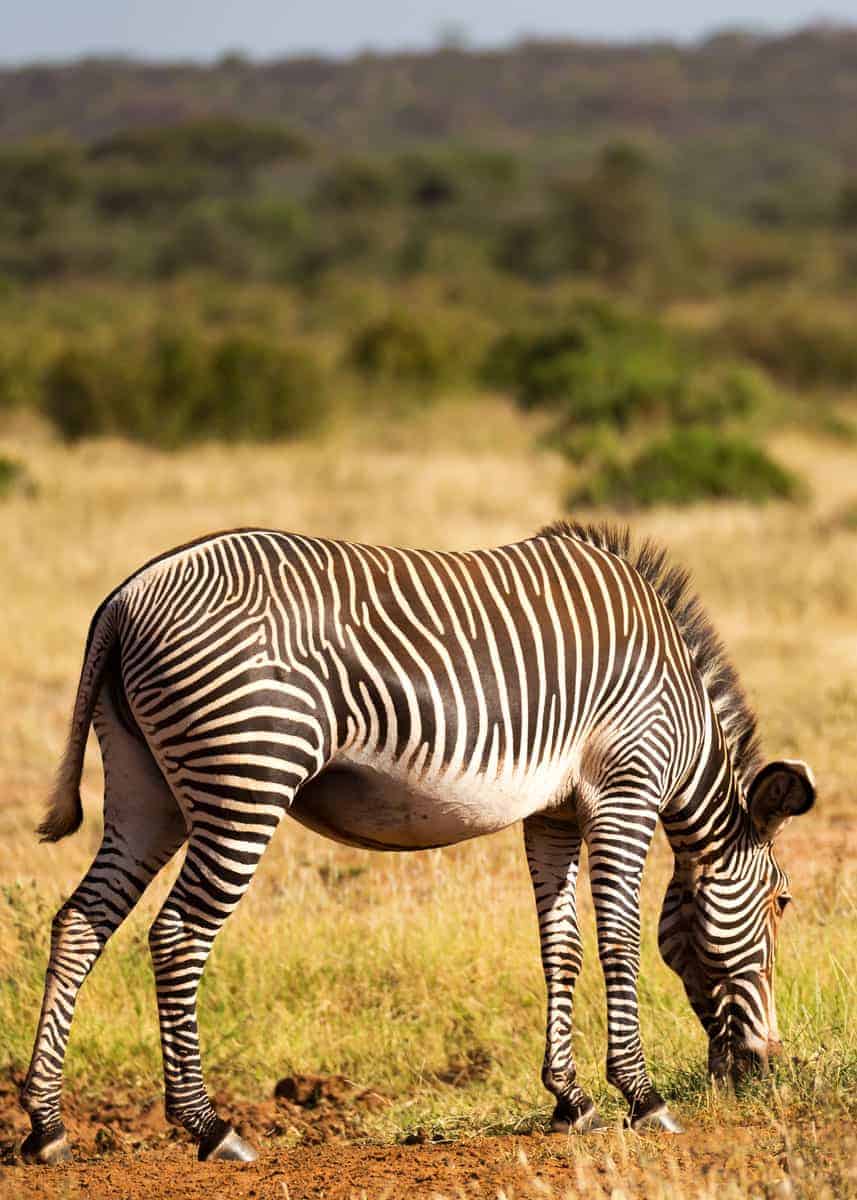
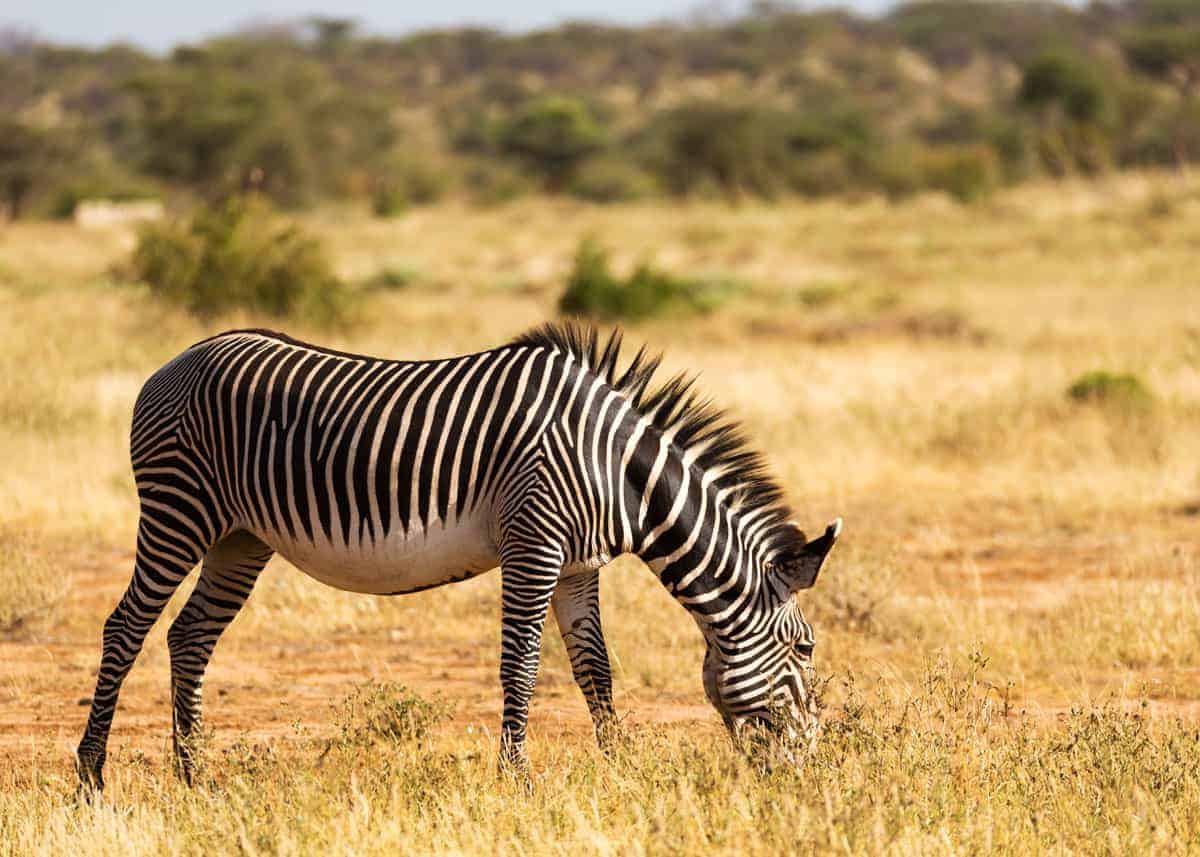
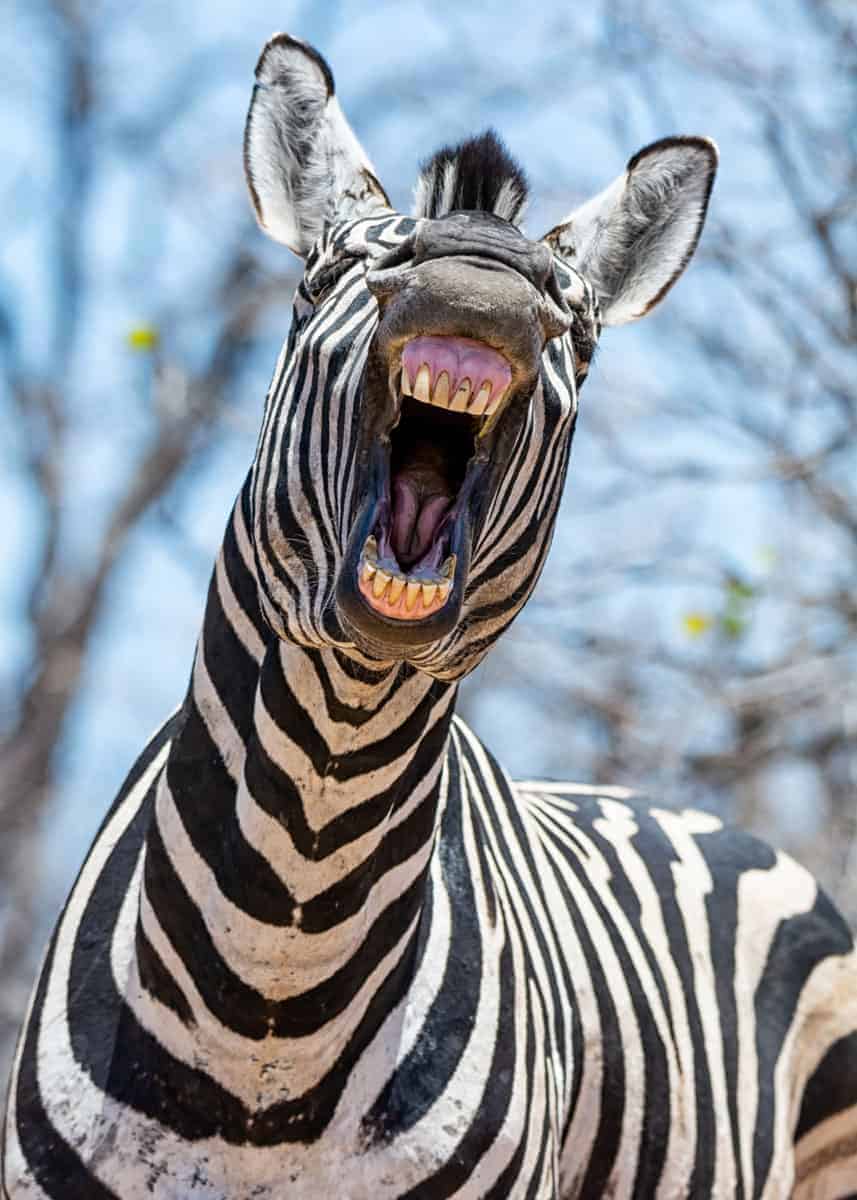
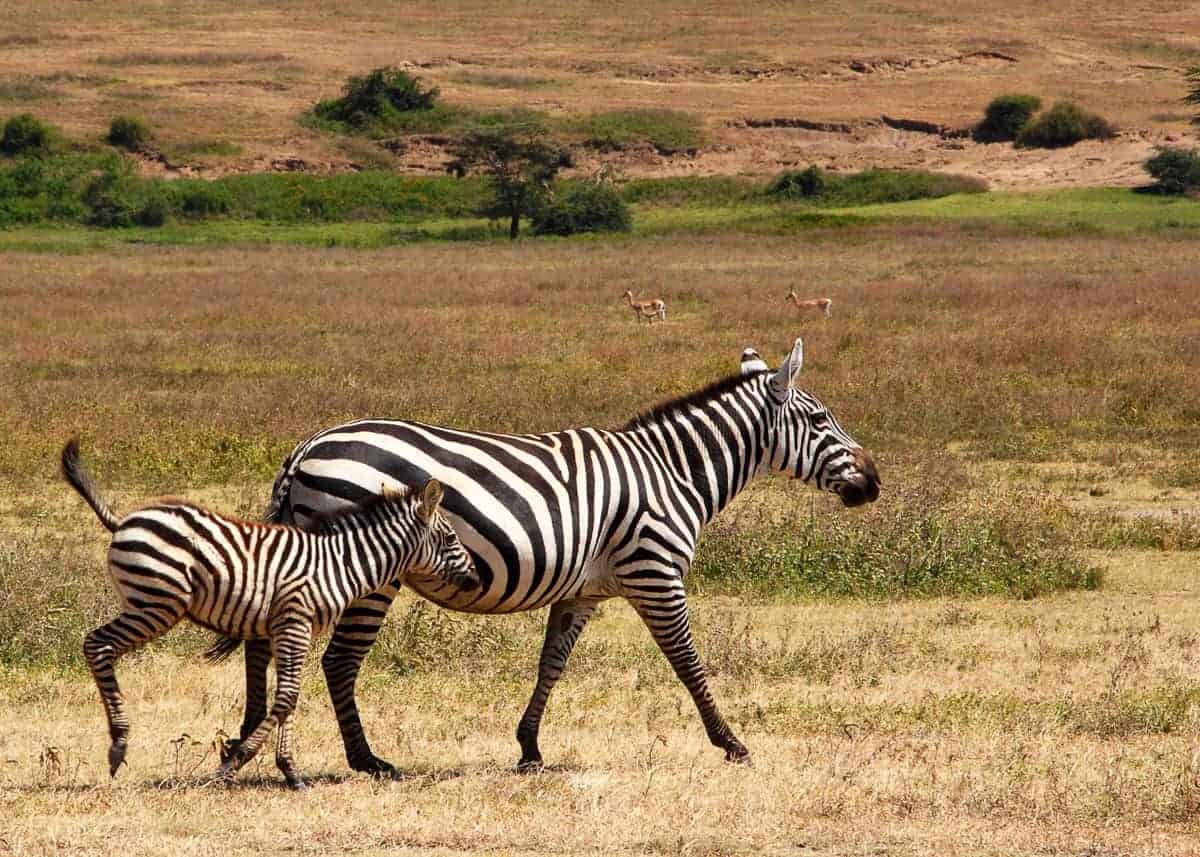
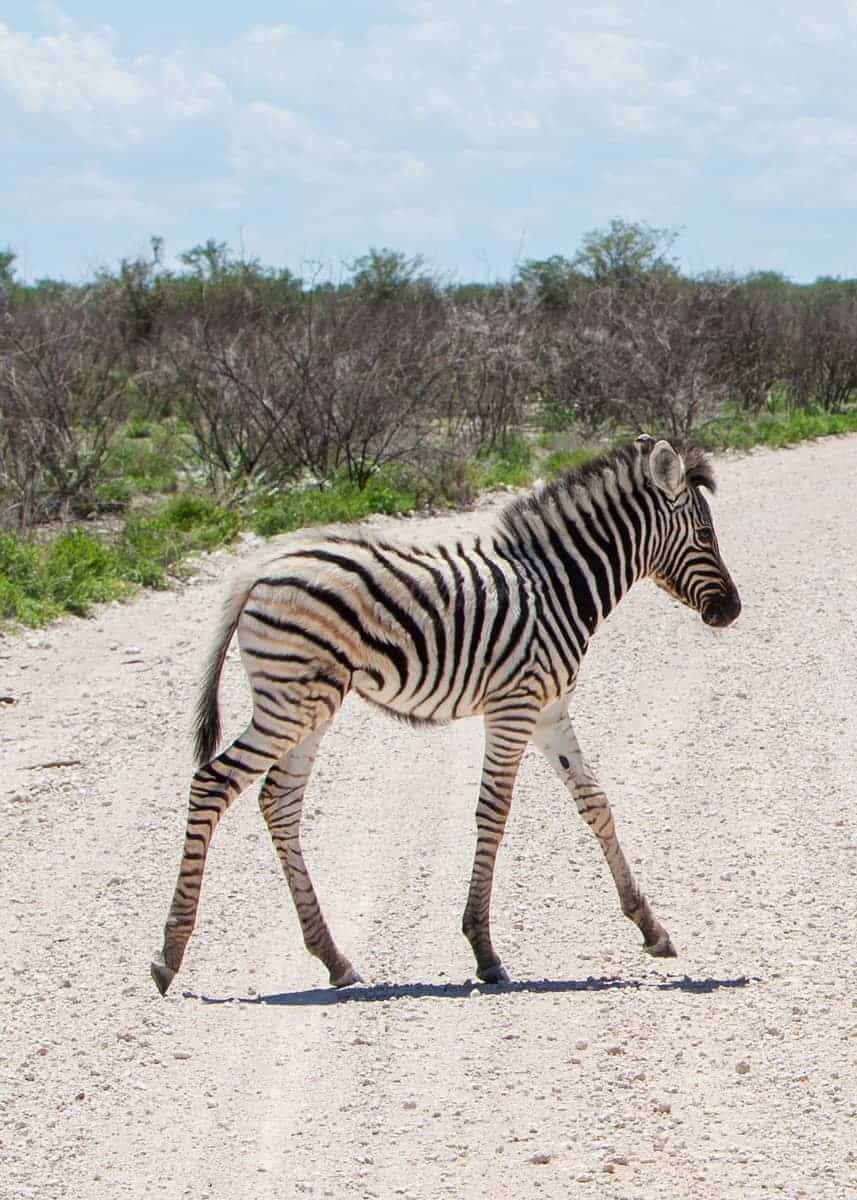
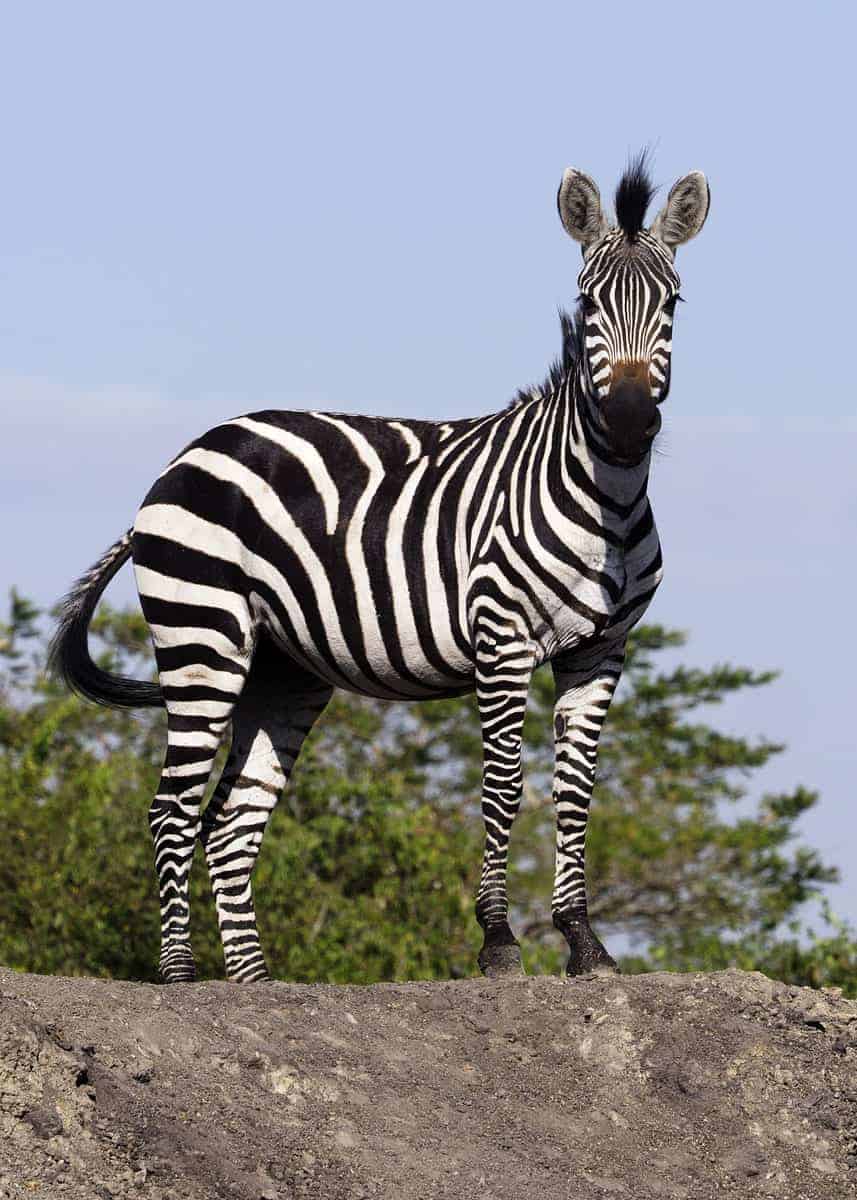

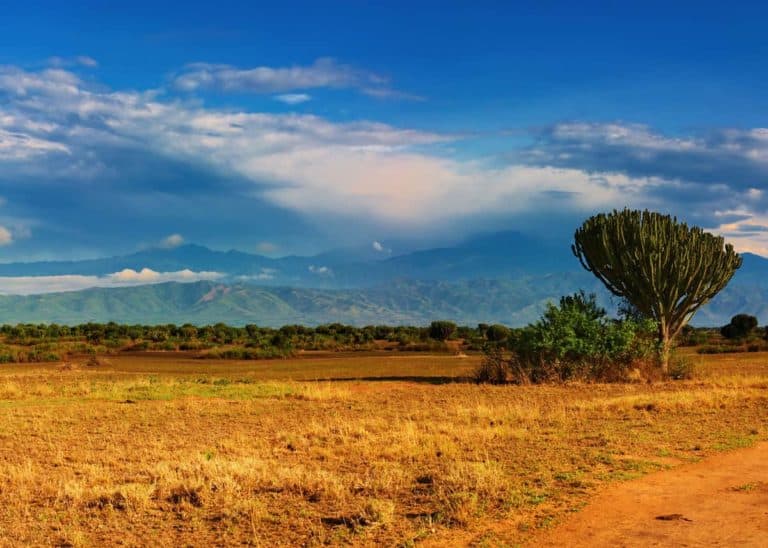




We have 14 month old twin zebras.
Hi…I’m age 74 and live in Lakewood… a Denver, Colorado, suburb. I rode, trained, and owned (16) horses over 50 years, including a plains (Grants)zebra hybrid back in 2001.
Your accurate coverage of the subject of “zebras, etc.,” is spot on and a pleasure to read. I gained even more knowledge in your explanations of weight, height, habitat, current endangerment. I was in contact with Mr. Rau in 2001 about the quagga project and he had sent me posters of the projects a couple times.
I used modern mule training techniques with my hybrid with good success, as I quickly discovered they are extremely smart and independent. Yet with all my years of working with horses, I don’t recommend ever owning even a hybrid… as I gained first-hand experience that the wild instincts are so strong that it would be foolish to be able to train or trust this gelding as I would a domestic equine.
Again, thank you for your in-depth coverage of the subject of zebras.
Thanks Jan!